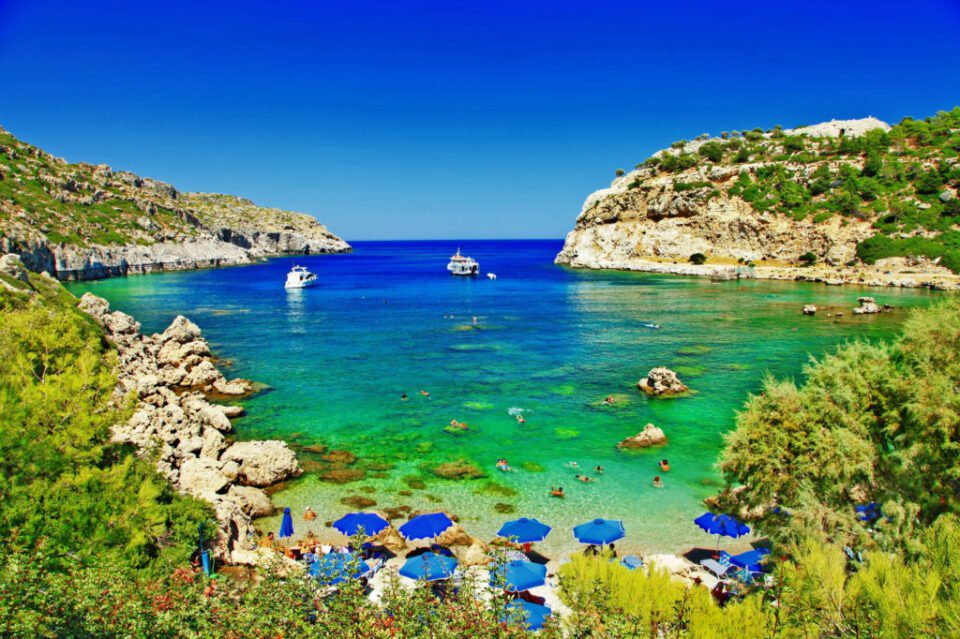Dive into the world of antiquity and the Middle Ages, passing by the dormant ruins of the temples of Aphrodite and Athena Pallas. Test your strength and endurance against the wind born at the meeting point of the Aegean and Mediterranean Seas. See the sea port where the Colossus of Rhodes once stood. And many more interesting attractions are offered to be seen in one trip, having learned what to see on Rhodes by car.
Advantages of Car Rental
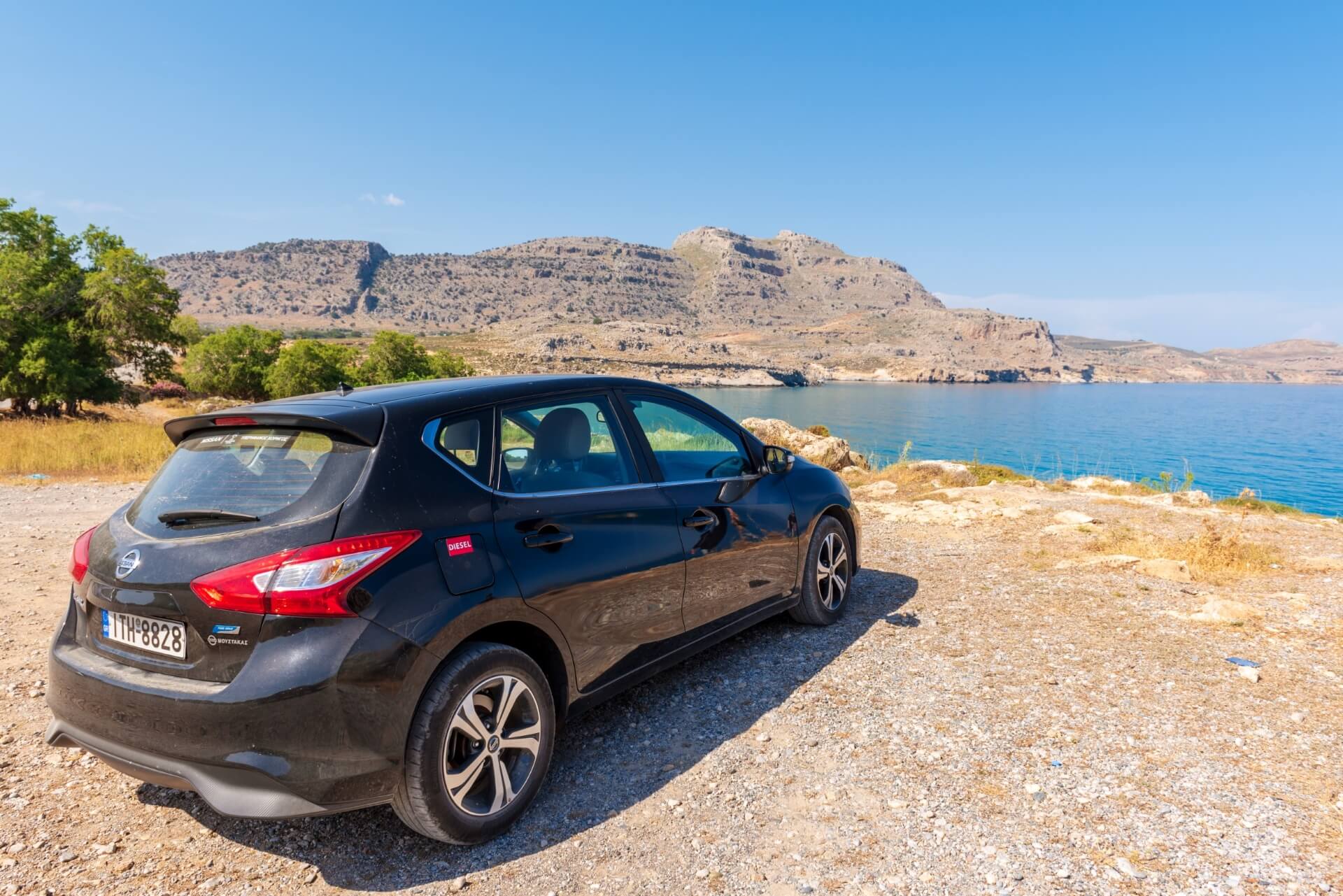
You can see the interesting places on the island during excursions. But it is not a cheap pleasure, and the traveler is always tied to the planned events. Traveling by shuttle buses will help you travel along the coastlines. Buses to the mountains, into the depths of the island (where many mysterious places are located) run infrequently.
You can book a specific car model in advance. Keep in mind that you can rent a vehicle from the age of 21 (SUVs from 23 years old). Rental is provided with a national driver’s license of the new type. Well-known international car rental companies operate in the country. Adapting to complex mountain serpentines and unfamiliar terrain can be challenging. Caution and driving experience are necessary.
However, the great reward will be the opportunity to tour the entire island. You can see the life of Rhodes’ unusual villages (about 42). Some are on the coast, while others “hide” among the mountains, far from known tourist routes. Many attractions (described by guides) have parking lots, gas stations, cafes. Even using excursion routes, it is easier to reach departure points by car.
Kallithea Springs
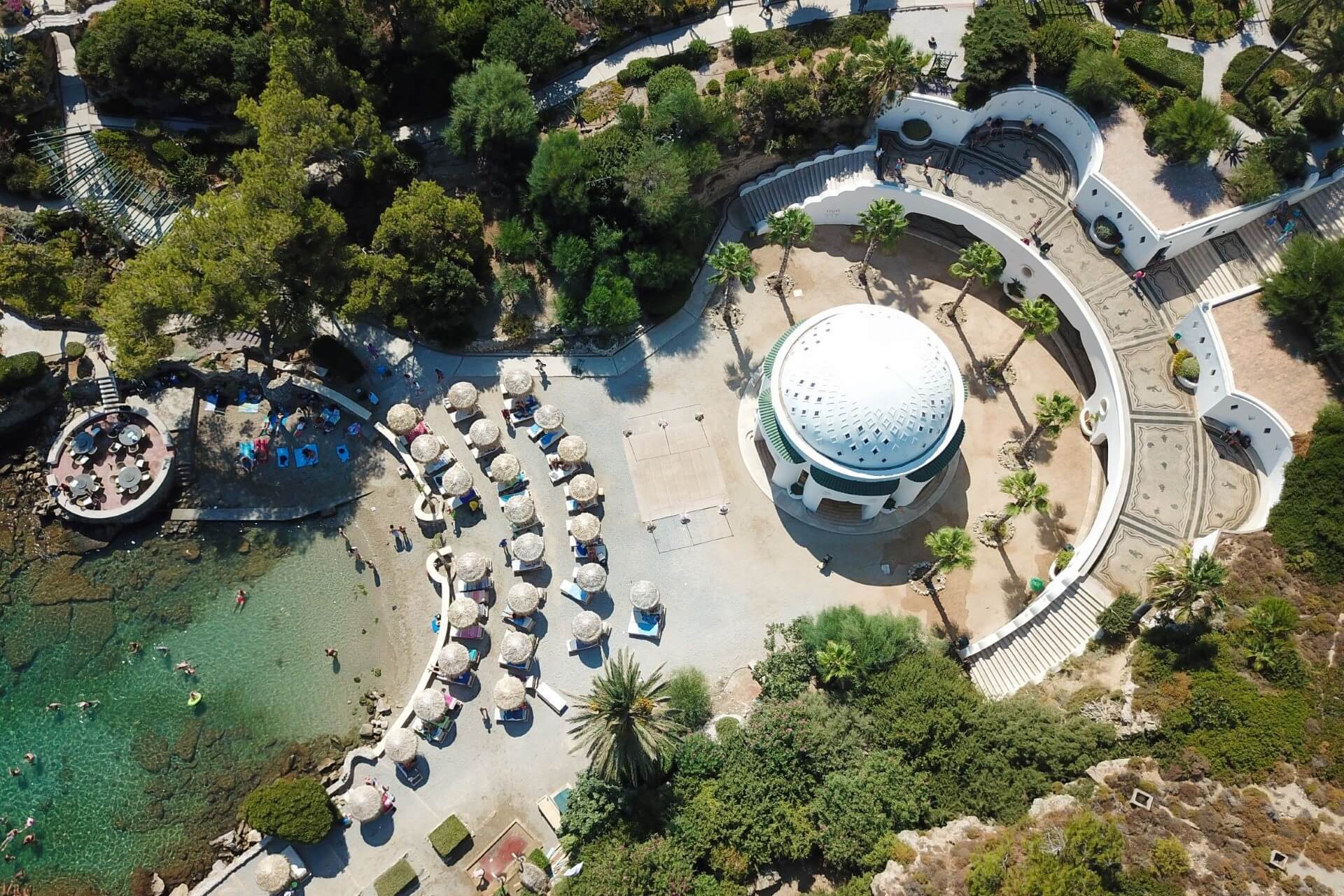
Their history is long, with tragic moments of destruction and stops. The modern hydrotherapy center, in terms of architecture, resembles ancient thermal baths. The complex includes large and small rotundas. In them, people drink water, walk, rest, and learn about the ancient and recent history of the revived springs.
The Kallithea Springs Museum includes a white art gallery that often hosts art exhibitions. The healing center’s procedures help people with stomach and intestinal diseases. The resort offers excellent beach vacation and diving conditions. The beach (sandy-pebbly) is accessible with a ticket costing 5€ (during the springs’ opening hours). Children under 12 are free. It is located in a nearby bay with surprisingly warm water. The springs are in the central district of Kallithea.
It is 8 km from the island’s capital and near Faliraki, filled with fun in nightclubs, restaurants, and discos. In a rented car, it is easy to visit the church with ancient wall paintings, the Traganou waterfront with famous caves, Ladiko Bay, and the Erimokastro fortress.
Anthony Quinn Bay

Closed by high cliffs and washed by the waves of the Mediterranean Sea, the bay has become one of the island’s beautiful beach spots. It has no fast currents, it is not visited by winds, and the turquoise water in the bay is always warm. There are no big waves here, ensuring comfortable swimming conditions. Entering the water should be done carefully: the bottom of the bay has many slippery stones.
For deep-water lovers, a pontoon is equipped over the stones. The shore of the bay is covered with small pebbles and large stone boulders. The bay’s name is associated with the famous actor Anthony Quinn. According to local legend, the actor’s activities are linked to the birth of the “Sirtaki” dance, which became a symbol of Greece.
In the bay, located in the northeast part of the island, is one of the country’s most beautiful beaches. It is fully equipped and has free entry. A set of equipment (lounger, umbrella) costs about 10€. There is a parking lot for cars nearby. It is located near a cafe in the upper part of the bay, offering a beautiful view of the surroundings.
Ladiko Beach
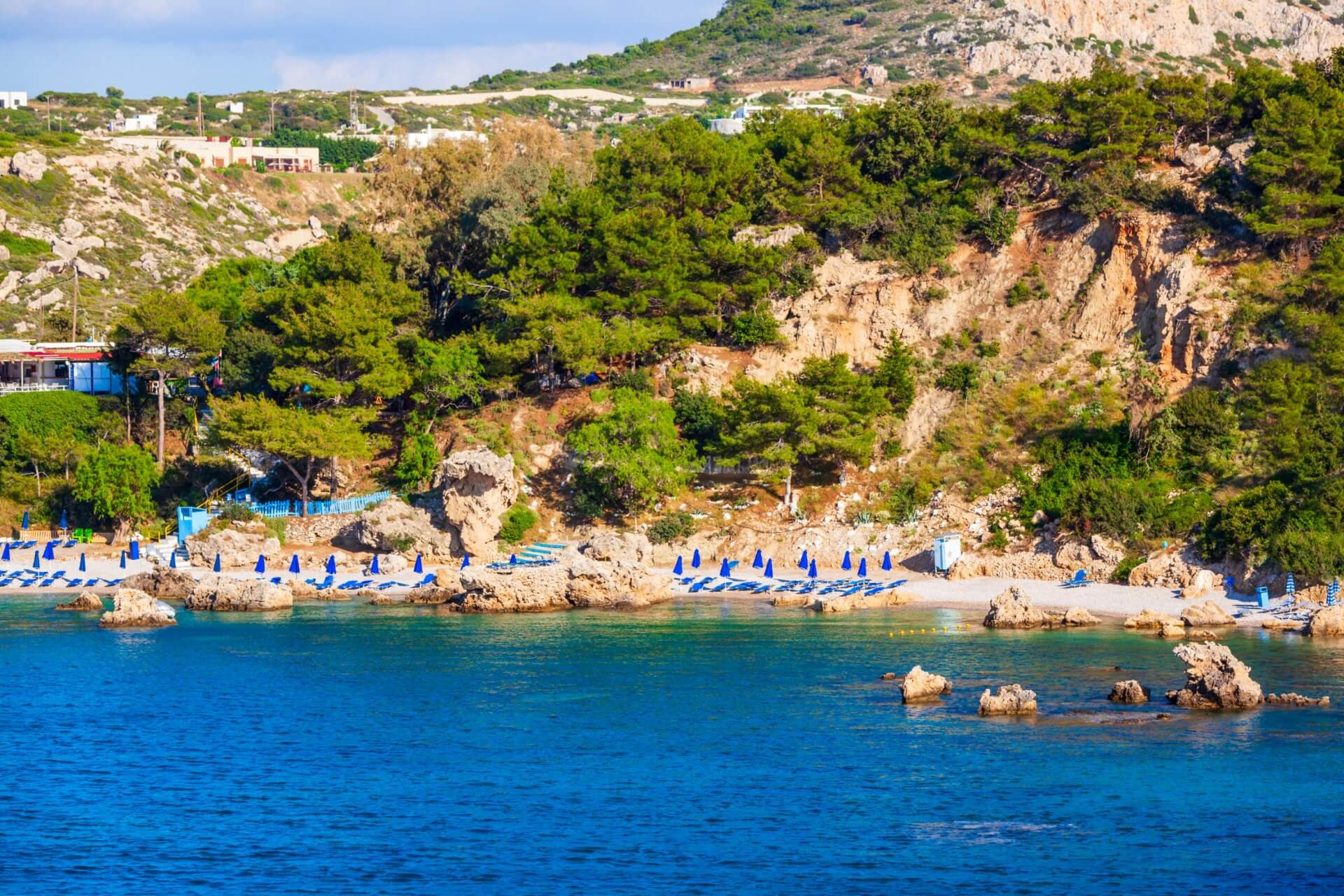
Near Anthony Quinn Bay is a small bay surrounded by picturesque cliffs adorned with local plants. A single cliff separates the two famous beaches of the island. Through the clear water, you can see the sandy bottom with scattered stones where fish and other marine life hide. Snorkeling and diving enthusiasts are attracted to them. A ladder is equipped for easy access to the water.
The beach area has two parts: one sandy and the other with small pebbles. Both areas have sun loungers, umbrellas, toilets, showers, changing cabins, and a cafe. Two loungers and an umbrella cost 8€. There is a parking lot for cars nearby. While relaxing on the beach, you should visit the neighboring Traganou beach and see the natural caves where an underground spring flows. You can do this by swimming through a tunnel with cold water.
Seven Springs

About 30 km from the island’s capital and 3 km from Kolymbia is a landmark that almost all island visitors strive to see. From an ancient mountain, seven springs with clean, cool water flow among beautiful nature. The water flows into an artificial tunnel created by Italians in 1930 and flows into a special lake. It is the only artificial freshwater reservoir on the island.
Tourists are invited to walk through the dark, narrow tunnel (150 m long with water about 15 cm deep). A ventilation shaft in the middle of the tunnel lets in a faint daylight. To attract tourists, there is a legend that after washing your feet in the cold springs, all sins are forgiven, and women become younger. The route to the springs follows the “Epta Piges” sign. There is a restaurant, souvenir shop, and parking nearby.
Tsambika Monastery
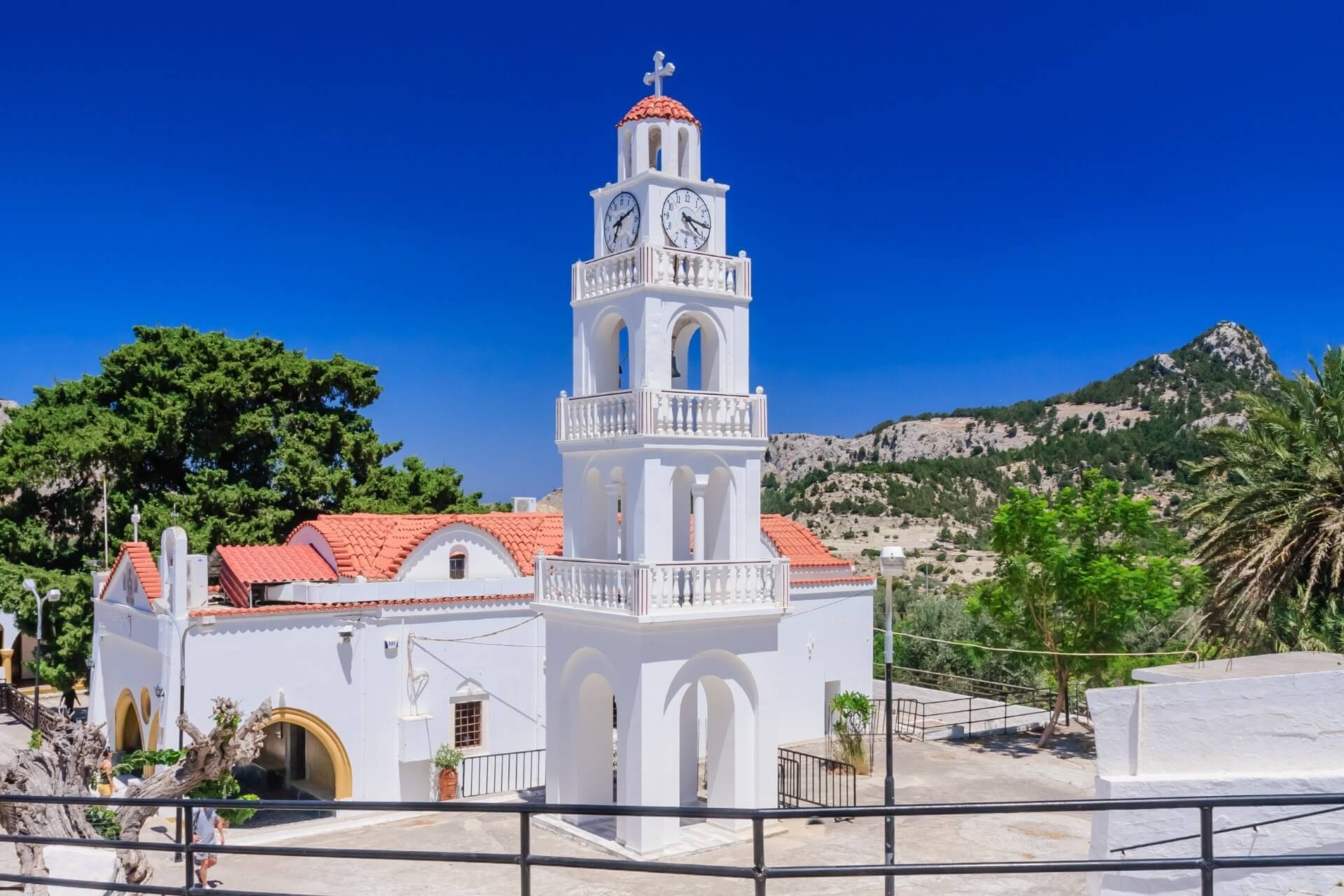
The construction of the monastery on the mountain’s peak is linked to the three-time appearance of the icon of the Virgin Mary, which disappeared from Cyprus. There are two buildings: the upper and lower monasteries. The distance between them on the highway is about 2 km. A steep mountain road and a staircase with 300 steps lead to the upper building. Every fifth step is marked with a number to help distribute the strength needed for the climb.
At the mountain’s base, there is a cafe and a souvenir shop. It offers special sets of consecrated belts, baby-shaped candles, and oils. According to ancient legend, women with pregnancy problems use them. During the climb, childless couples read prayers. Every year on September 8, the icon of Saint Tsambika is carried up from the lower monastery, and festive services are held in her honor (in the 17th-century church building).
The original miraculous icon is kept in a small white stone church in the lower monastery (a copy of the icon is kept above). You can learn the icon’s history at the Orthodox museum on the monastery grounds.
Haraki
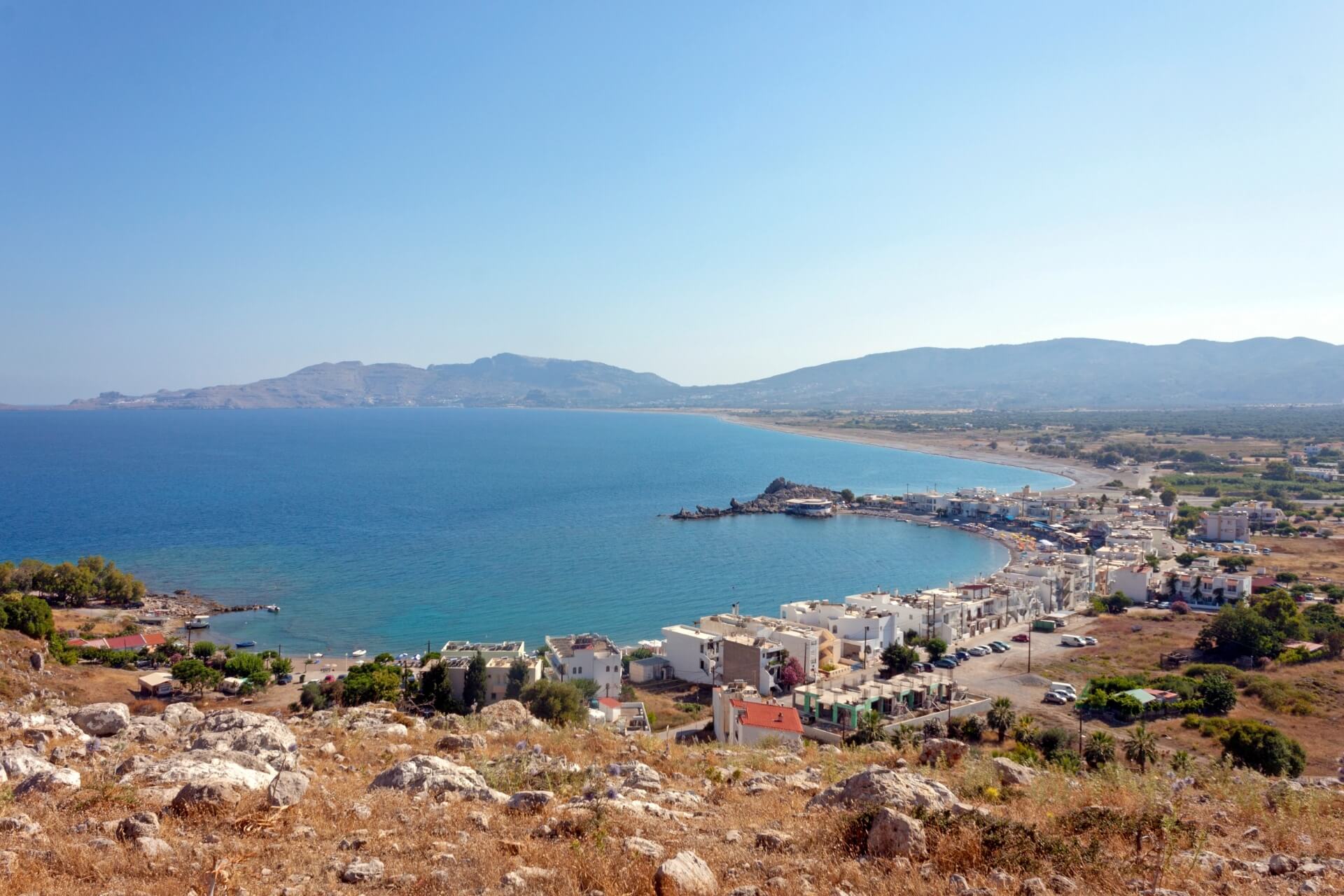
A small fishing village on the island’s east coast is 38 km from the capital and 13 km from Lindos. Now, it is a resort with hotels owned by locals. Beach lovers come to the small harbor’s beach zone for a quiet rest. The beach is crescent-shaped and covered with small pebbles and soft golden sand. There are sections with large pebbles at the beach’s edges.
The gentle slope into the water but the sudden depth near the shore allows for an exciting journey into the underwater kingdom. Relaxing on loungers under cozy umbrellas, you can admire the ruins of the medieval Feraklos castle surrounded by a fortress wall. On these slopes, millstones from an ancient sugar factory, which existed before the Hospitaller knights’ era on Rhodes, were found.
Climbing to the ancient citadel’s top, you can see the beautiful city of Lindos. Haraki has several luxurious modern hotels, restaurants, and cafes. There are numerous entertainment options, including water activities for active recreation enthusiasts.
Agia Agathi Beach
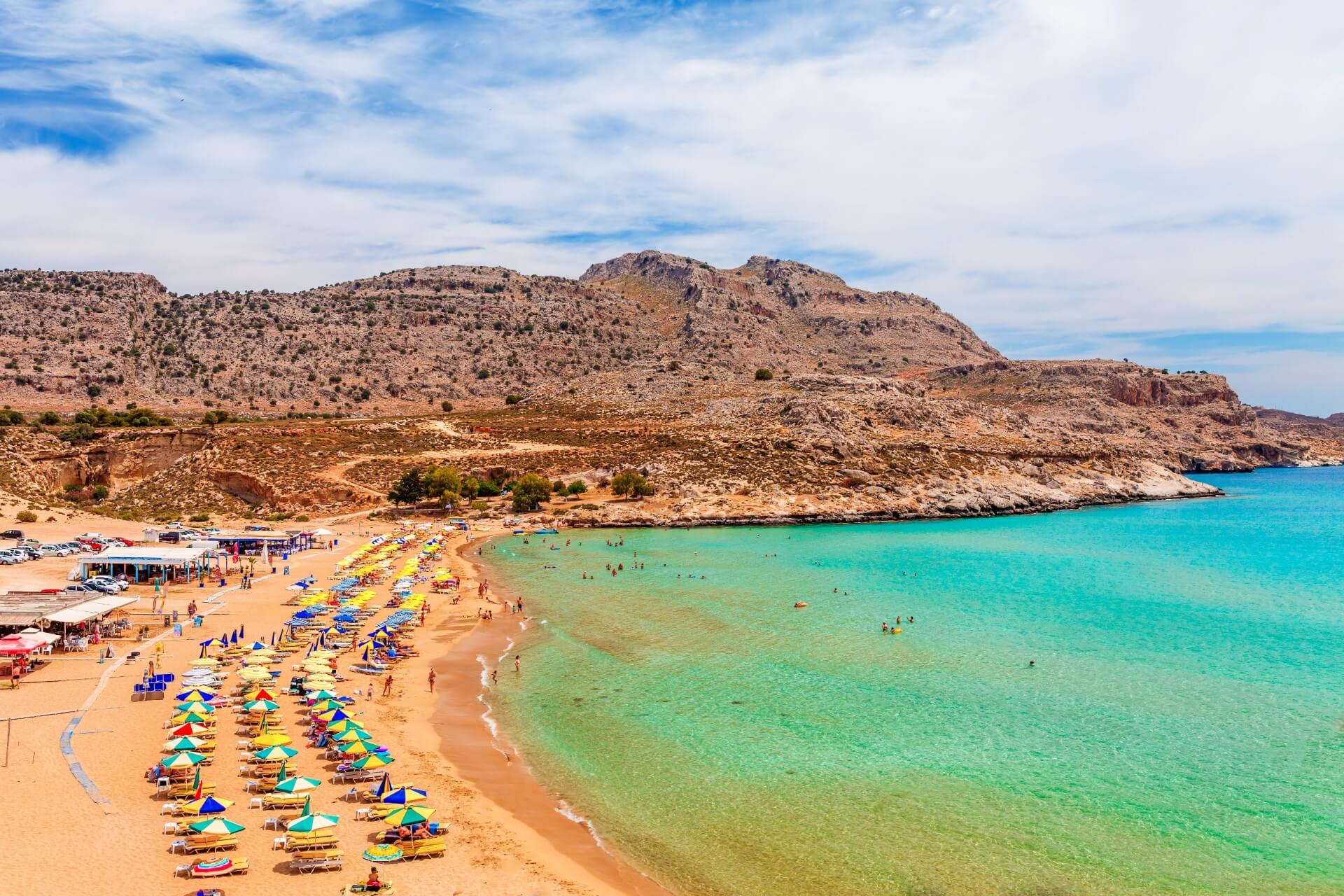
Agia Agathi’s recreation zone naturally continues Haraki Beach. It is named after a small chapel that grew unnoticed on the rocky shore. The beautiful bay, protected by a pine grove and mysterious cliffs, has a sandy (sometimes with small pebbles) shore, calm clear water with a convenient slope suitable for small children. It is often chosen not only by vacationers but also by beautiful ducks and turtles.
The beach’s modern infrastructure allows for a wonderful rest. The beach has playgrounds, sports equipment rental for surfing, diving, water skiing, jet skiing, and offers exciting sea trips. Taverns on the shore offer original national dishes. Resting with the whole family on Agia Agathi (translated as “Holy Purity”) gives an extraordinary sense of calm and coziness. The visit to the unique church carved into the rock complements the peace.
Lindos
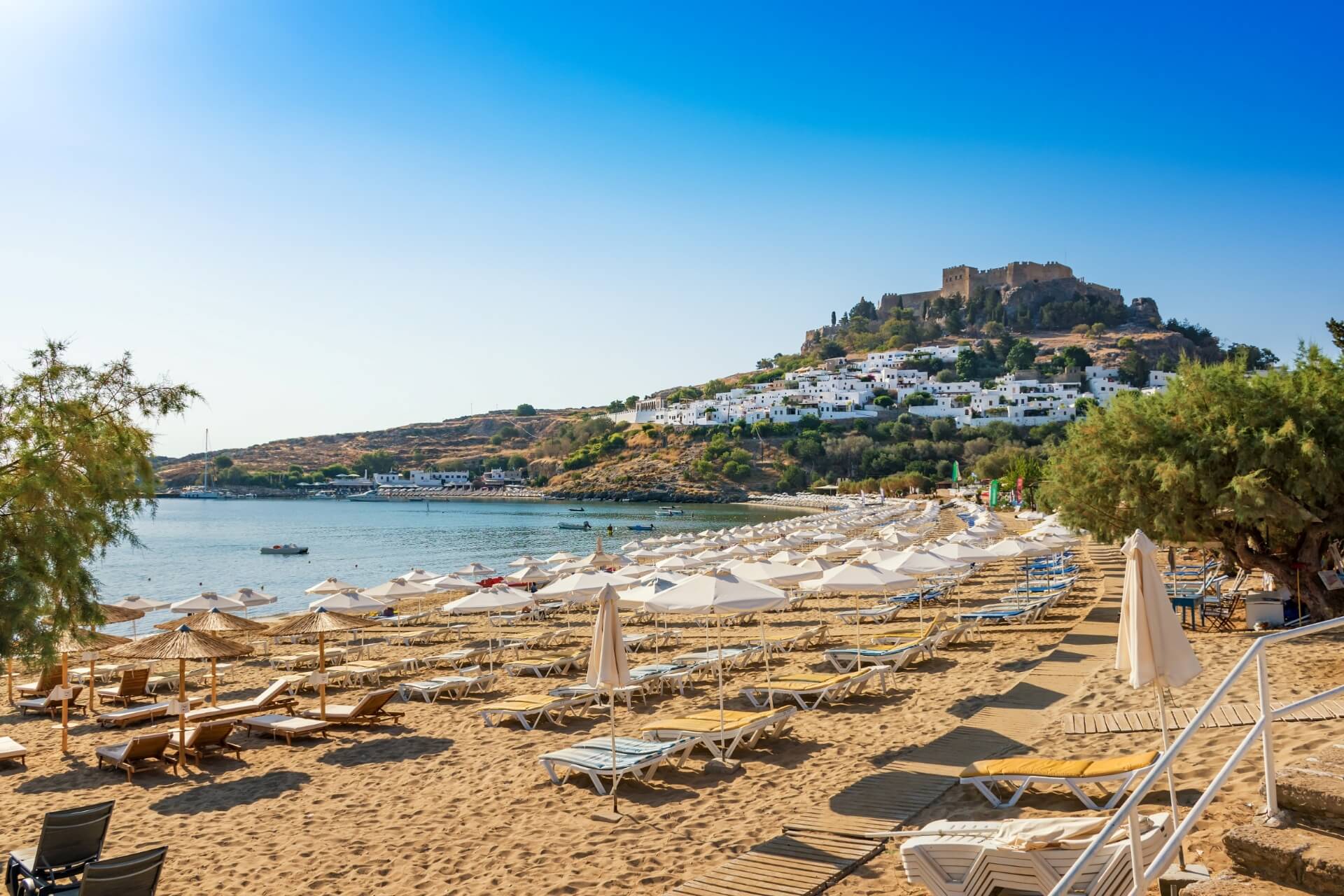
One of the most popular vacation spots on the island is the resort town of Lindos. It is 56 km from Rhodes City. The ideally clean beach (awarded the “Blue Flag” for several consecutive years) on the Mediterranean coast is covered with silky sand, has a gentle entrance to the sea, and safe conditions for family vacations. Many colorful fish swim in the sea, approaching people and feeding on bread crumbs.
This always brings joy to young children. With fins, a mask, and an underwater camera, you can have an exciting underwater photo shoot. The shallow coastal sea is always well-warmed. The recreation zone has changing cabins, toilets, and showers. For active recreation enthusiasts, sports equipment for sea trips and entertainment is available.
There are no unpleasant strong winds or dangerous currents in the bay. In this town, with the arrival of the Apostle Paul, Greece’s new religion was born. Near the beach, a mountain rises with the ruins of an ancient acropolis. You can explore them by climbing 116 m (donkeys can be rented from locals). Archaeological excavations are carried out on the ruins of the Temple of Athena Lindia. At night, the remaining structure is illuminated with special lights, creating fantastic scenes.
Monastery of Saint Panteleimon
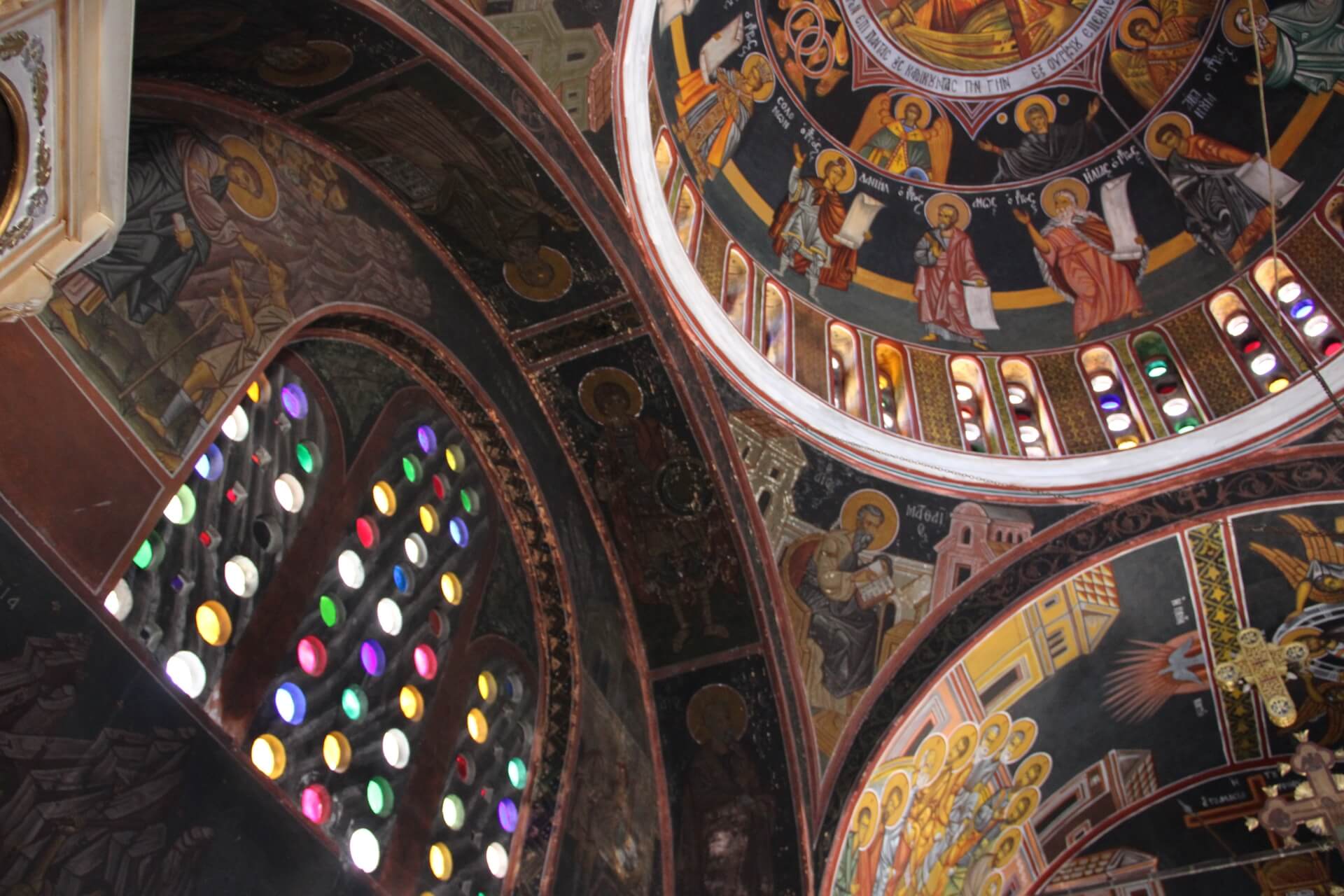
The history of Rhodes, spanning 2,400 years, includes the best architectural achievements of different cultures: from Hellenistic churches, early Christian times, Byzantine monasteries, Ottoman Empire mosques to Gothic structures. They majestically demonstrate Greece’s religious and cultural heritage.
Ancient Christian temples and monasteries rise across the island. One of the most revered is the Monastery of Saint Panteleimon, located in the village of Sianna. It was built using the remains of an early Christian basilica. Relics from the ancient temple are still kept in the monastery. Saint Panteleimon was a great martyr, healer, and miracle worker. Now, small particles of the saint’s relics are kept in the monastery. The extraordinary life story of the saint is depicted on icons.
Inside the monastery, it is very beautiful. To the left of the rich iconostasis is the saint’s icon. The monastery grounds have two five-level bells. Regular services attract many believers seeking healing. Guests can visit the souvenir shops on the village’s main street and purchase church goods.
Prasonisi Cape
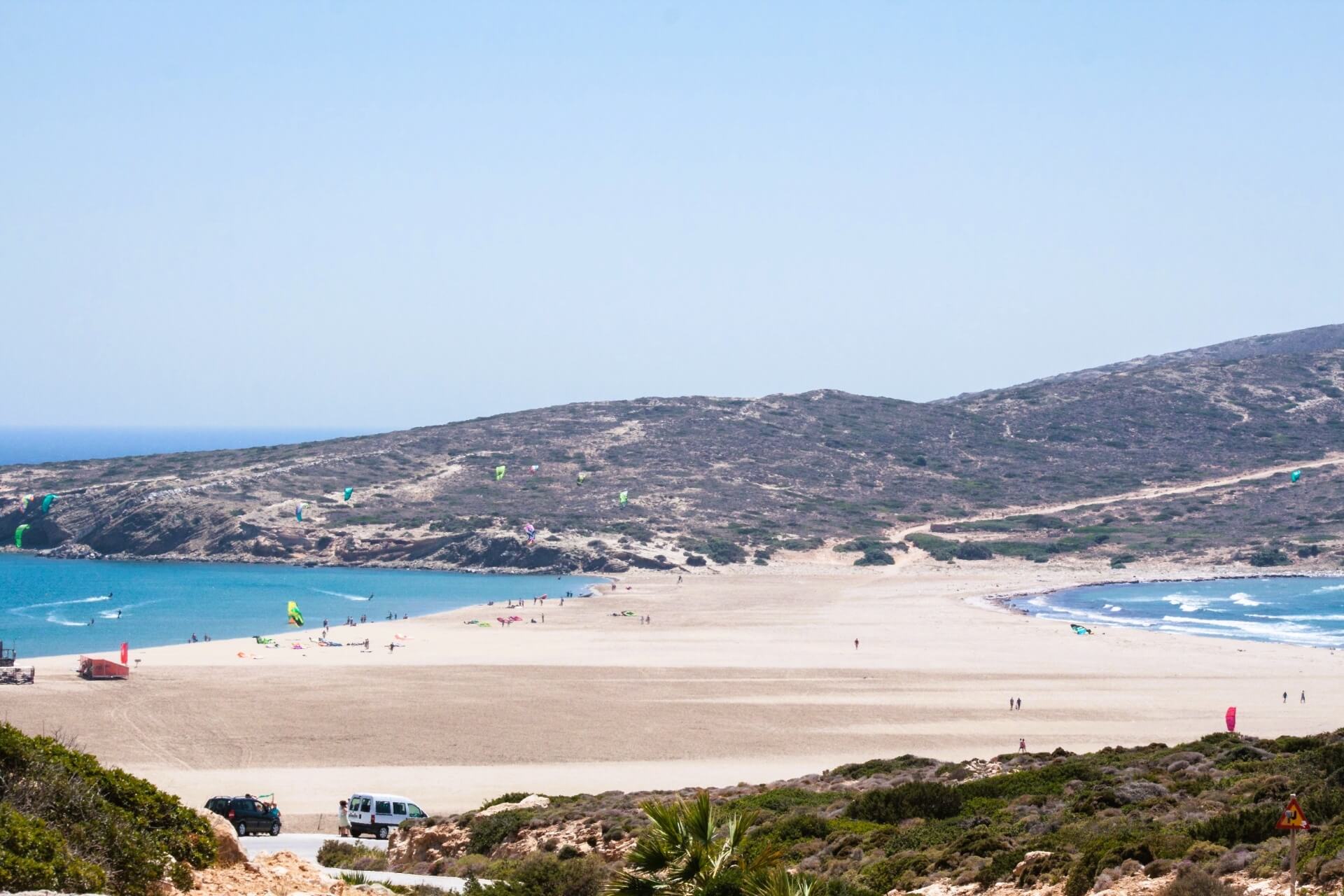
Having a rented SUV is the best means of transportation and temporary housing at the amazing place where two seas meet. As a temporary residence, you can use the services of the only nearby village – Katavia (the nearest town is Lindos). The cape is at the island’s southernmost point and is connected by a sandy spit (500 m long and 100 m wide) to Rhodes. This happens in summer, but in winter and autumn, the isthmus is flooded with water.
Due to the different water densities, the boundary of the two seas’ meeting point is well visible by the different water shades. Due to the significant temperature difference, the wind is born here, creating sea waves. They attract windsurfing enthusiasts. You can always not only swim in two seas simultaneously but also rent any gear and ride the sea waves.
Handmade attractions on the cape include a lighthouse built in 1890. The structure is 14 m high. Together with the keeper’s house, it is made of stone. You can reach it by SUV, and then an extraordinary view of the two seas’ meeting point opens from the hill. There is convenient parking and a cafe near the beach.
Gennadi Beach
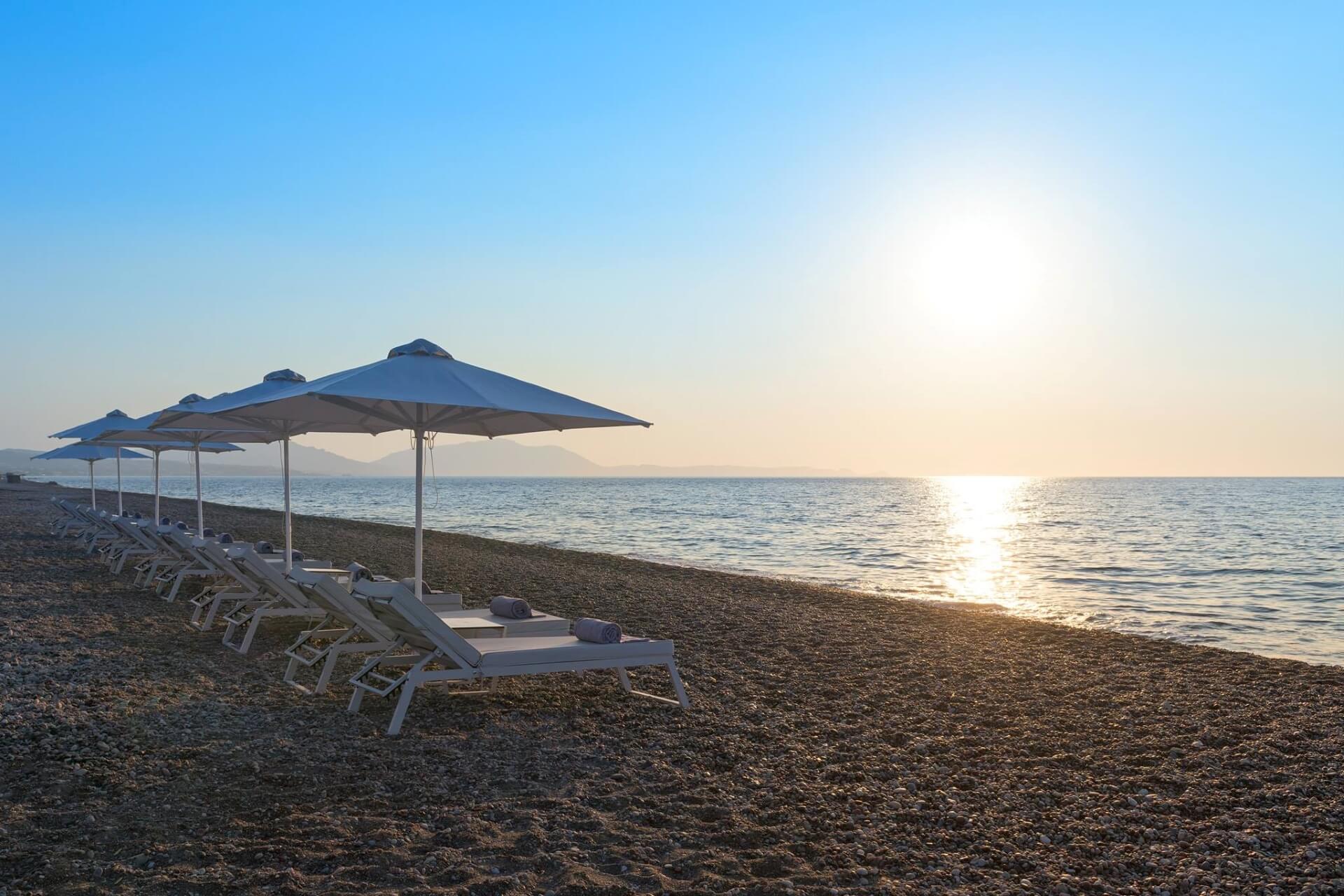
There are many beach recreation zones on the island. The coastline is almost 220 km long. It has well-known, crowded places and quiet, cozy beaches visited by locals. The main resort zones are on the calm Mediterranean Sea’s east coast. Such a cozy resort town grew on the site of the small village of Gennadi.
It is 65 km from the capital and 18 km from Lindos. The resort managed to create a modern beach kingdom infrastructure while preserving the national color of a traditional Greek village. Hotels, shops, currency exchange points, internet access, car rental, and sports equipment rental have appeared here.
Along with beach relaxation, it is always interesting to walk along the narrow paved streets of the ancient settlement, sit in small private restaurants and cafes, enjoying national cuisine. The town’s main attractions are the 12th-century Church of Anastasia the Roman, the Church of John the Theologian, and the local police station building. The main attraction, the beach, hosts fun parties and Sunday dances until morning.
Fanai Village
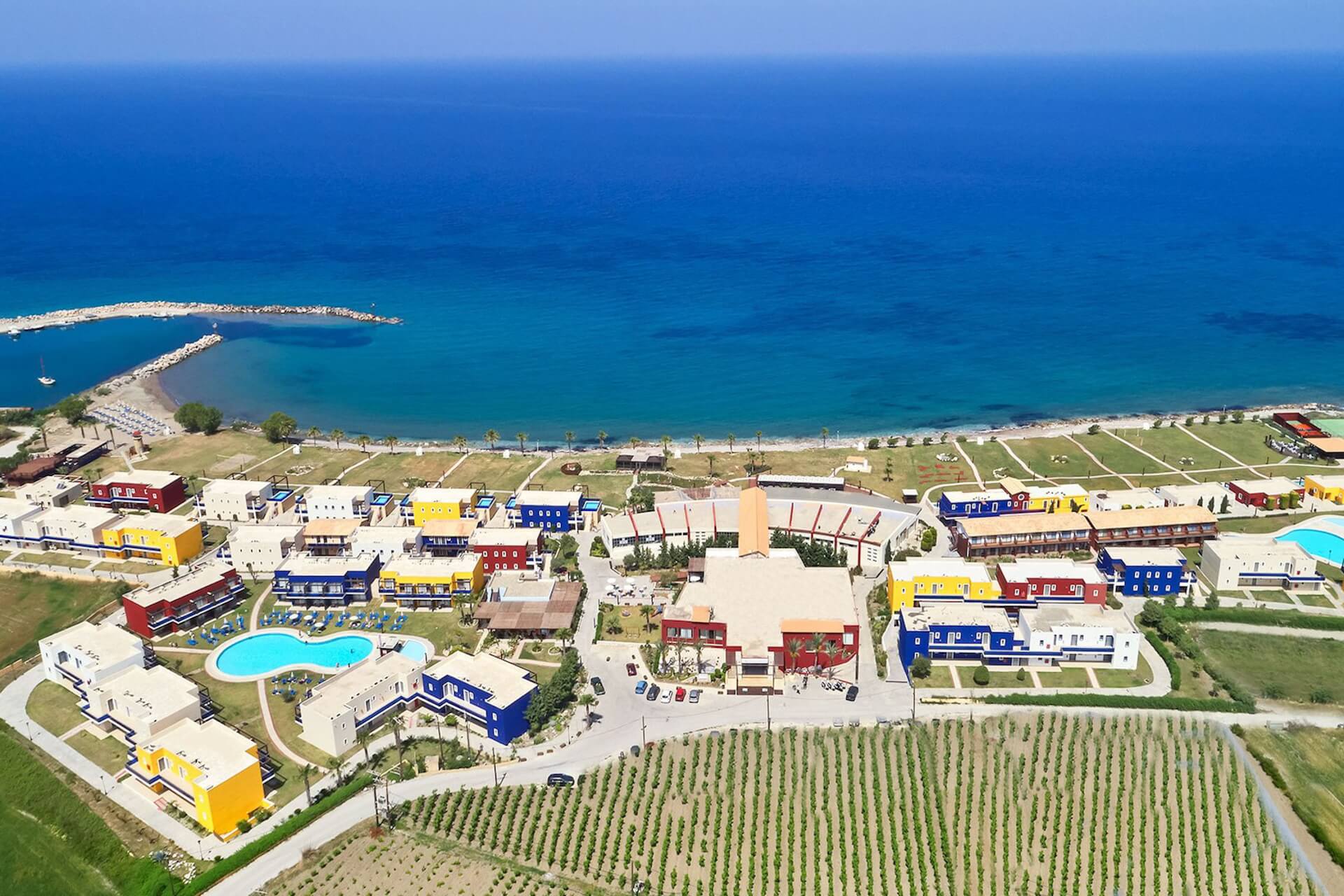
Each village on the island has its individuality. Seeing them, hearing local legends, and trying treats are not always possible during popular excursions. Only by coming by car can you truly feel the unique places on the island. One such interesting place is the village of Fanai.
It became a colorful, fairy-tale holiday by the idea of local youth: to paint all the village houses before Easter. The new look was realized in 2011 under designer Lucas Nikolicis’s guidance. The 72 village houses played with bright colorful drawings, attracting a huge flow of tourists.
A tradition of holding art festivals and fairs featuring various crafts (including ceramics and paintings) was born. After resting in a cozy cafe, visiting the local beach, and trying original fish (and other) dishes, guests always buy souvenirs made by the colorful village’s craftsmen. You can get there by the main road from the airport to the sign (about 10 km).
Ostrich Farm
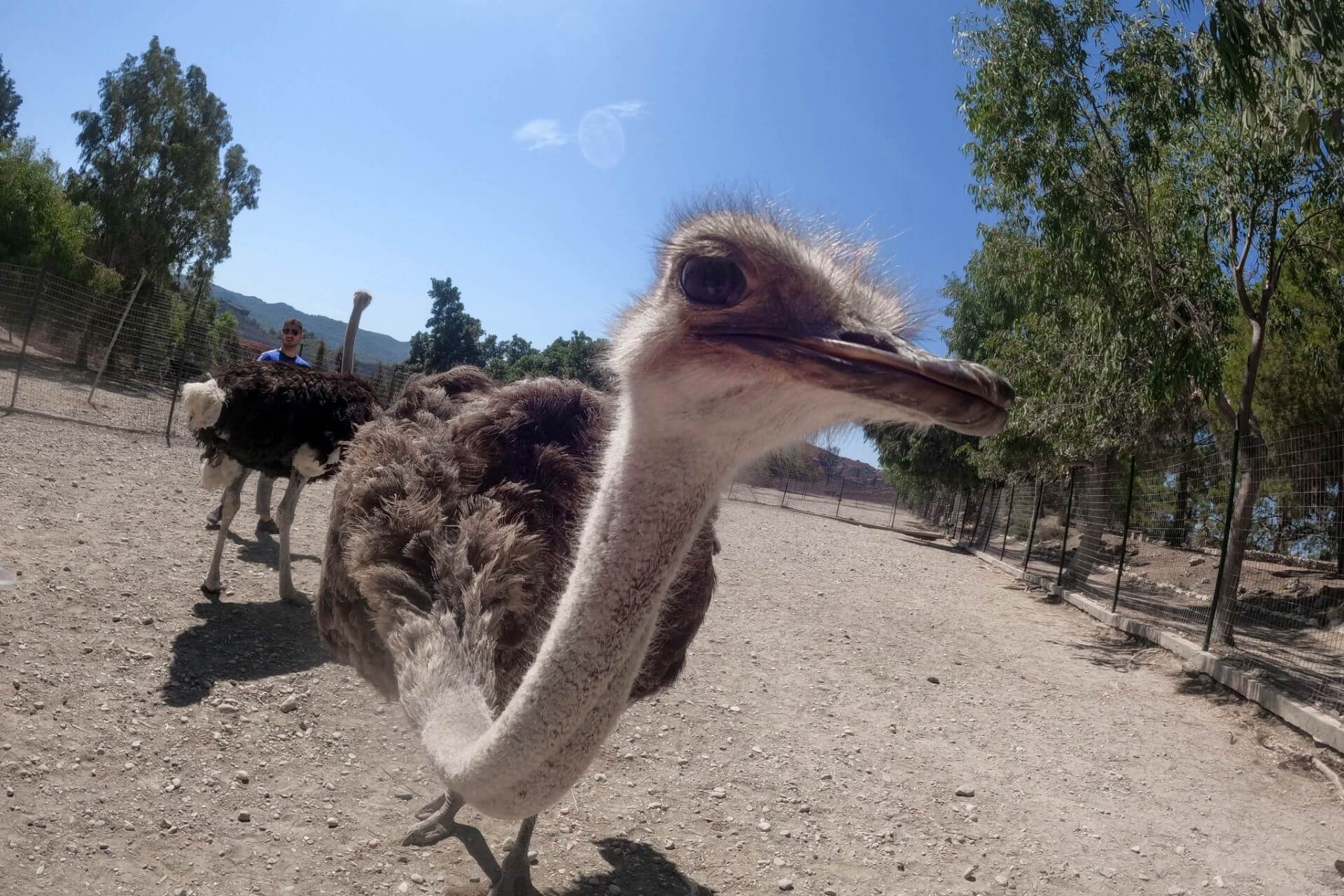
The trip will be very interesting for children. You can book a tour on-site, but it is most convenient to arrive by car without wasting time. Communicating with nature and unfamiliar animals and birds is offered on the ostrich farm. About 20 different animals, camels, ponies, kangaroos, and monkeys are kept in safe enclosures for children.
You can buy a bag of corn and feed the animals, ride a camel. But you should be careful with ostriches. African ostriches are strong birds with unpredictable, surprisingly curious characters. Their strong legs make you think before wanting to pet the feathers of the majestic bird.
It can easily peck, break a mobile phone, or camera. The guide tells about the ostrich’s life and warns about its nearest desires. There is a tavern near the farm where you can try an ostrich egg omelet and meat platter. In souvenir shops, you can buy original souvenirs from bird feathers and cosmetics made from their fat.
Valley of Butterflies
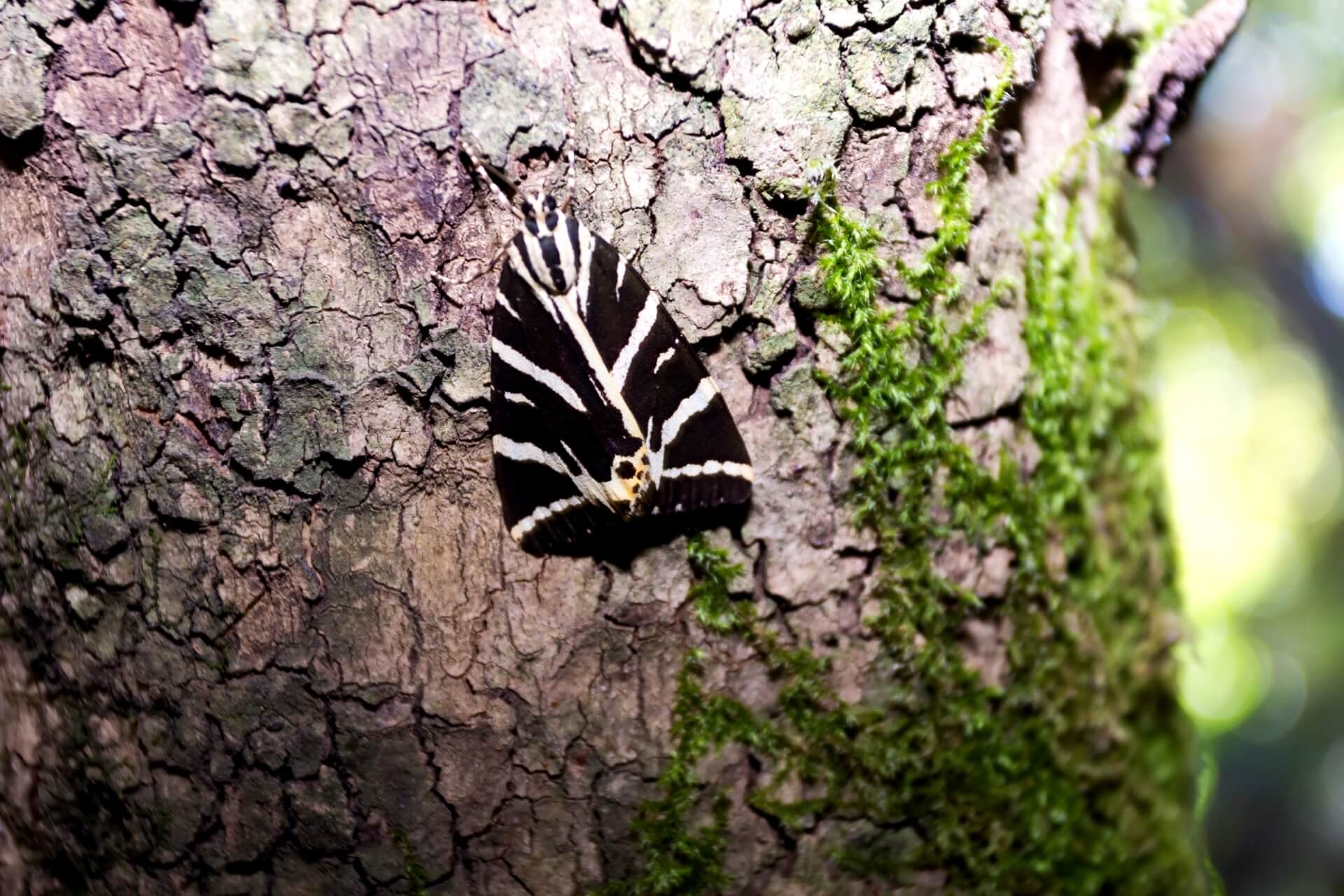
A pristine corner of nature is located in the Petaloudes Valley on the island’s western side. Butterflies of the “spotted harlequin” species chose this place for their permanent stay. They are not among the famous bright butterflies, but their number creates a colorful living carpet of fluttering moths.
The hot island climate is diluted here by numerous streams, creating ideal conditions for butterfly reproduction. The valley grows their favorite styrax trees with fragrant, sweet resin attracting the moths. They come here from June to September. The spotted harlequin lays its larvae elsewhere. Here they have a holiday, fun.
Remember that they die from sudden noise while observing the dancing kingdom. The valley is equipped for peaceful walks. There are many shady alleys, gazebos, clean streams, and an artificial lake. There is parking at the lower entrance. The Natural History Museum operates in the valley with a small exhibit of the island’s plant and animal life.
Monastery of Saint Nektarios
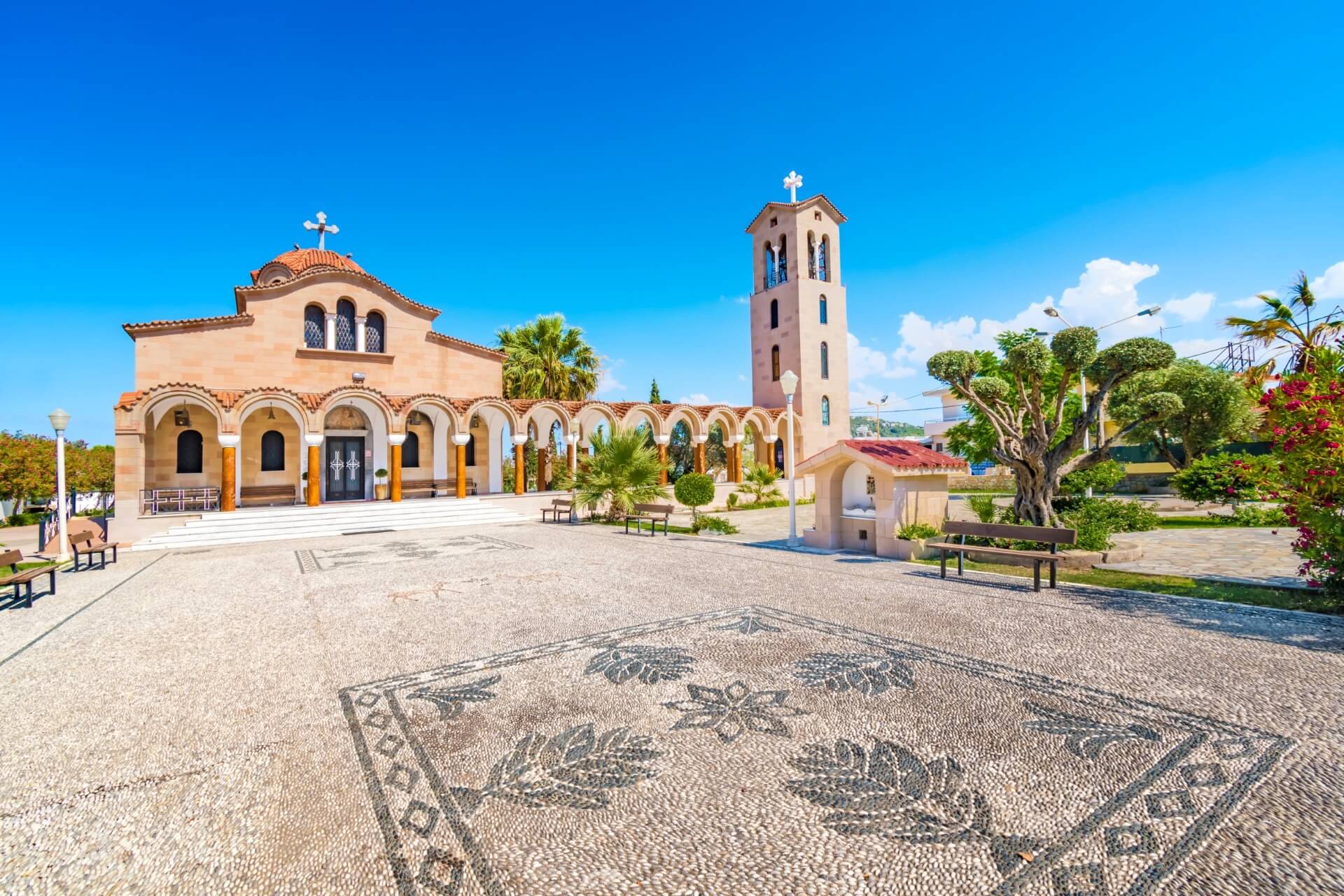
The island has two churches built in honor of Saint Nektarios. He is often compared to the Russian saint Seraphim of Sarov. One is on a hilltop (240 m), 3 km from the village of Archipoli. This 14th-century monastery is decorated with rare ancient frescoes. A stream with healing water flows at the hill’s foot. Many pilgrims come here for healing from cancer. Saint Nektarios heals and helps solve financial problems.
An oak tree with a huge hollow grows next to the monastery. It is several centuries old. It is considered the island’s oldest tree. Every traveler strives to enter the hollow. To reach the monastery, follow the island’s east coast to Kolymbia, then turn towards Archipoli. There is parking and a tavern near the monastery building. You can buy mountain honey there. The beautiful area is often used for weddings, baptisms, and picnics.
Filerimos Mountain
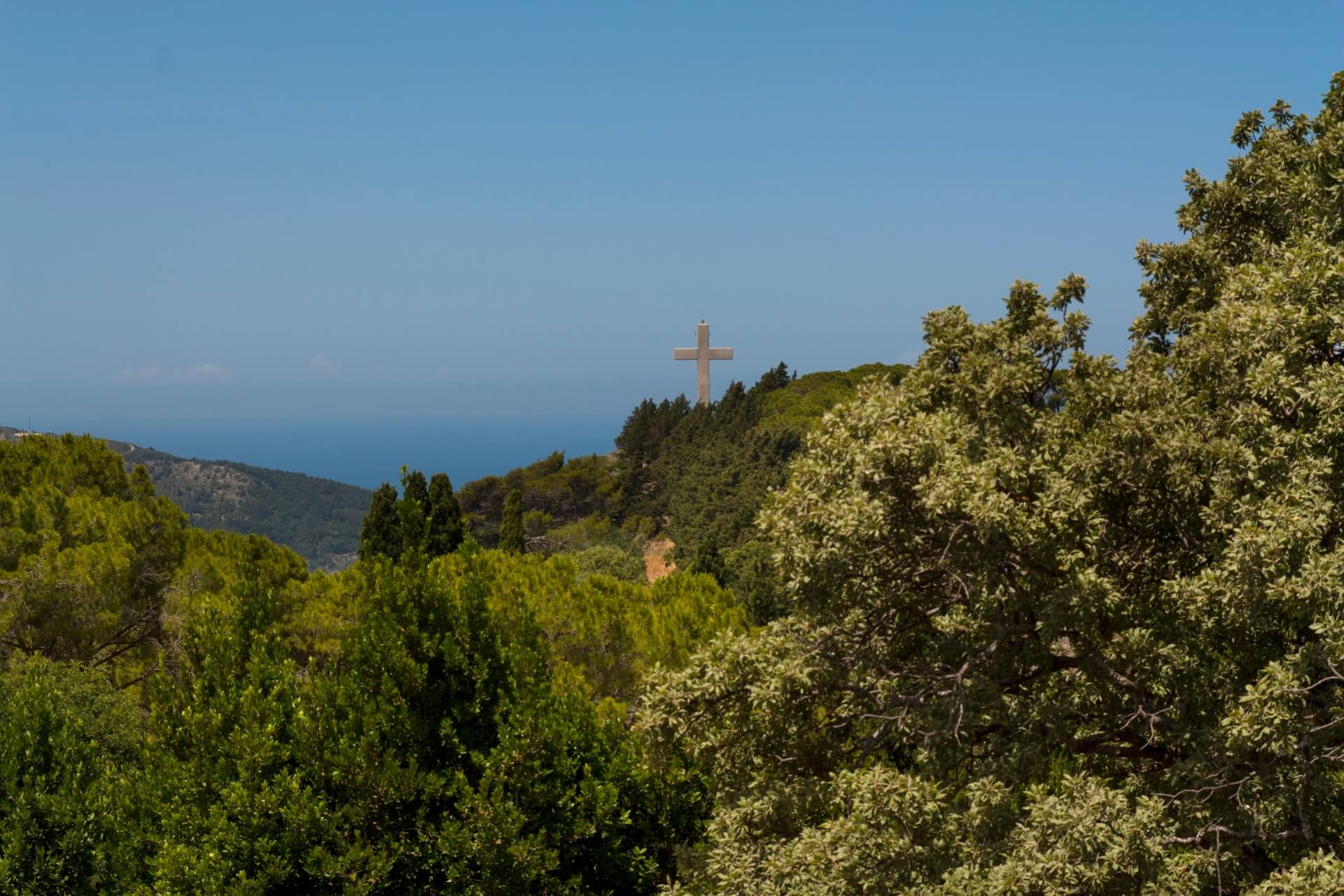
The mountain gained fame from the route called the “Path to Golgotha.” A cypress alley leads to the top. Its length equals the path Jesus took, bent under a heavy burden. Stone steles (proskynitaria) depicting the Lord’s suffering scenes were erected along both sides of the road. Local monks built a cross on the mountain’s top. Initially, it was made of wood but was later replaced with a stone structure.
The cross is 16 m high. Inside, it is hollow and has a spiral staircase leading to the viewing platform. It is very narrow, and the ascent is considered with visitors: it is difficult to pass on the stairs. The mountain is in a reserve zone.
It operates daily from 8 to 19 hours. The entrance fee is 3€. The mountain is almost 280 m high. A road leads to the mountain’s foot. There is parking for cars. You can climb with a tour or independently. The huge mysterious cross can be seen long before the hill’s approach. It arouses interest and respect.
Mandraki Port
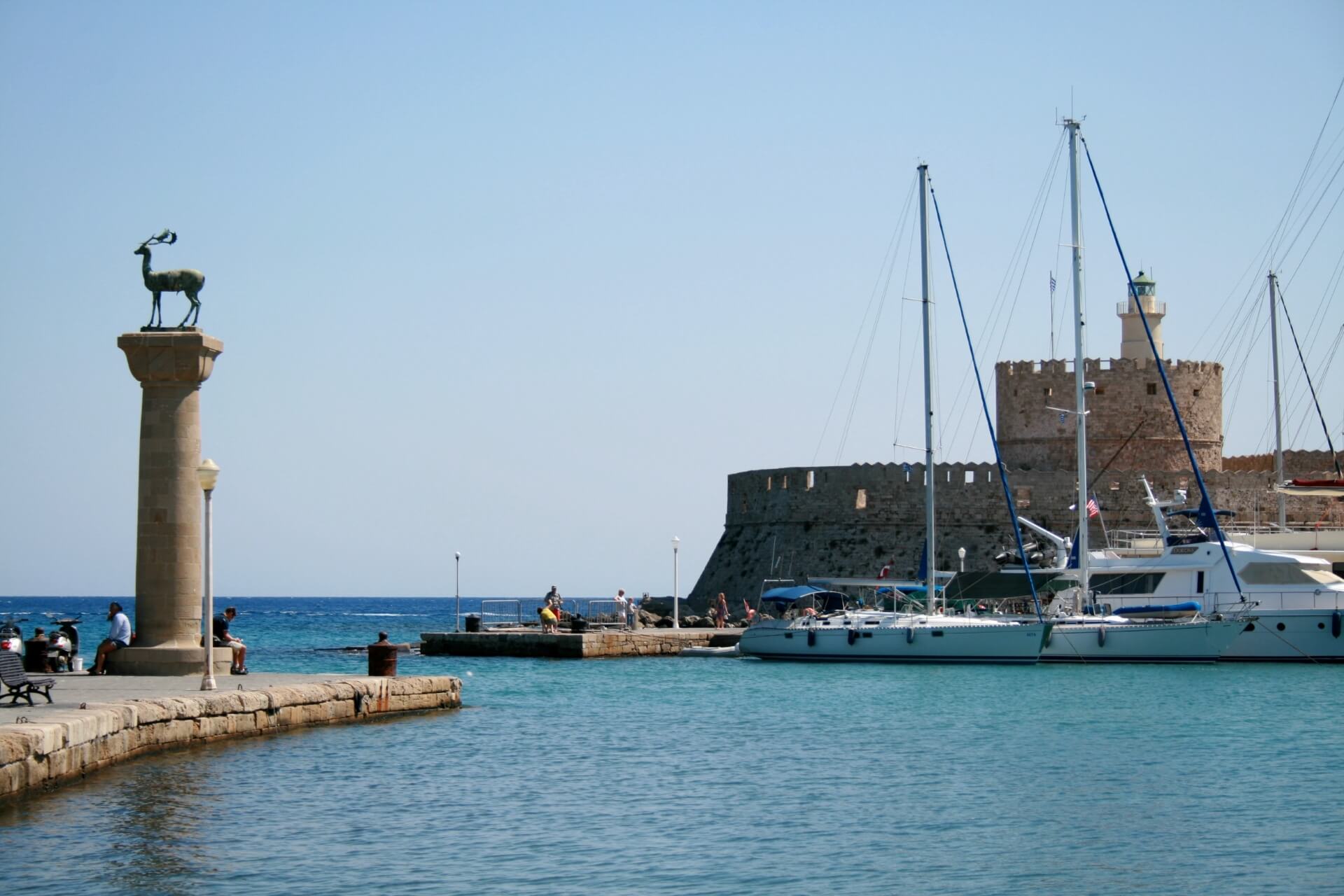
The island tour begins with the ancient port of Mandraki, which has over 2,000 years of history. The legendary Colossus of Rhodes statue adorned the ancient military port. Ships sailed between its legs. Now, heraldic animal statues (stag and doe) greet ships at the bay’s entrance. Modern liners with tourists dock at a special pier. Numerous ships, yachts, and fishing boats fill the port’s space.
Among the port’s attractions is the Annunciation Church building. It was built in the type of Saint John’s Church in the 16th century. Even earlier, a Byzantine fortress stood here. The medieval fountain in front of the building still operates. Three windmills on the old breakwater still grind grain brought by merchants.
A walk along the waterfront evokes a desire for romantic travels on a beautiful brigantine with scarlet sails. There are paid and free parking options near the port, such as in front of the market.
Ancient Kamiros
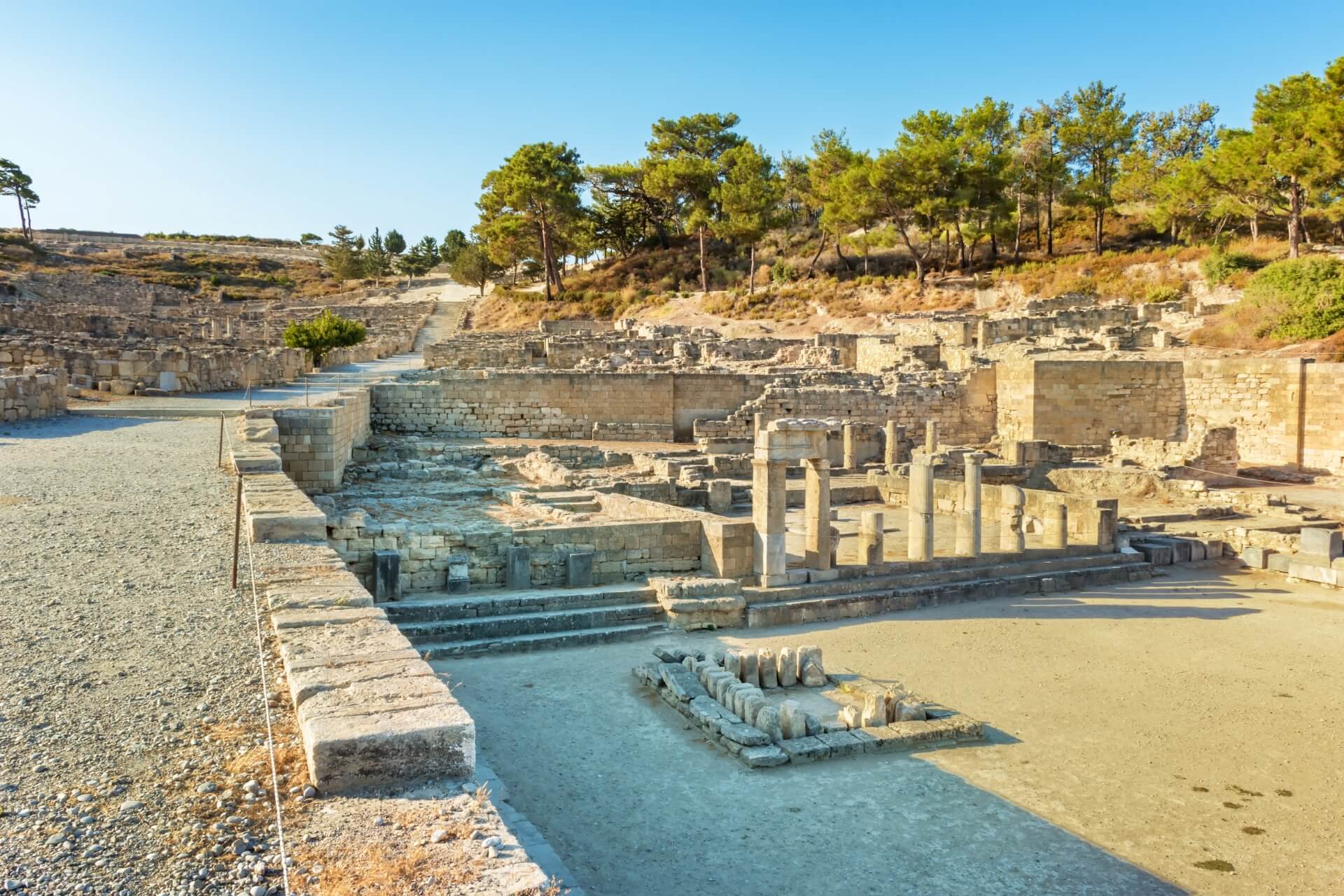
There is still no definitive scientific opinion on why the residents left the ancient city, which played an important role in Rhodes’ history. The remarkable city has no found defensive structures. At the same time, the ruins of temples, an ancient reservoir, the central square (agora), and numerous artifacts (they became part of the Louvre, British Museum, and Rhodes Archaeological Museum collections) are preserved.
You can still see the Kritos and Timarista stele in the museum, made in the 5th century BC. The ancient city’s ruins are the country’s most interesting archaeological monument, called the “Greek Pompeii.” The city’s main temples were built in honor of Poseidon, Artemis, Zeus, and other gods. The city’s main street led to the Acropolis, near which stood the Temple of Athena. The beginning of the excavations was marked by the accidental discovery of burials in 1859. The archaeological wealth of Kamiros has only been unearthed by 30%. Future excavations are expected to reveal new secrets of the city’s life during the Hellenistic period.
Monolithos Castle
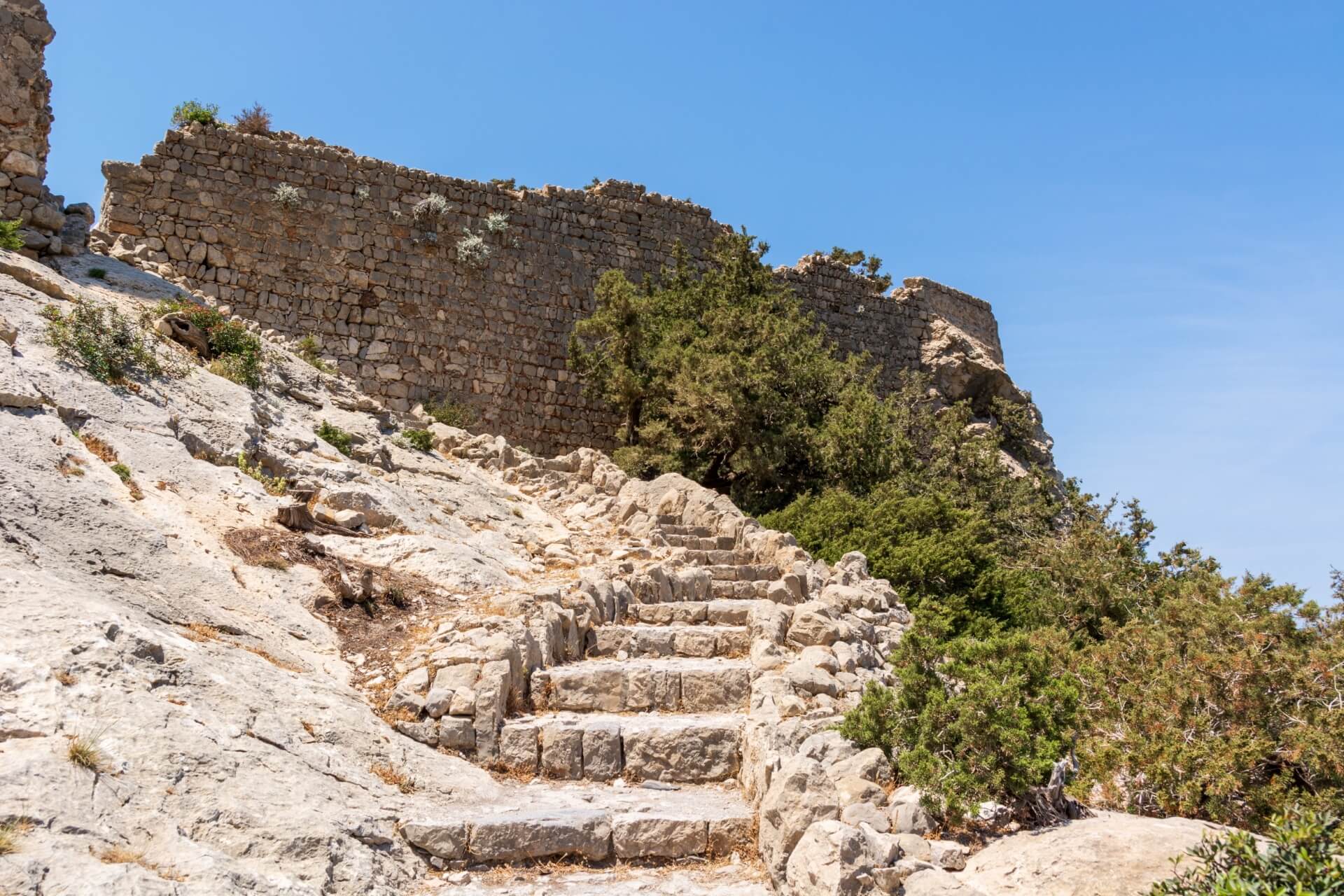
Medieval castles were always surrounded by powerful fortress walls. They were impregnable to enemies and provided an excellent view of the surroundings. One such castle, along with a fortress built in the Byzantine style, was Monolithos. It stands on top of the Akramitis rock in the Aegean Sea on the island’s west coast.
The architectural masterpiece was built in 1476. The disappeared necessity of using the fortress led to the desolation and destruction of all structures. Now, only the stone ruins, which inspire admiration, can be seen here. Strangely, the chapel of Saint Panteleimon (which is still active) and the ancient cisterns used for collecting drinking water have been preserved. You can climb to the top of the rock by a staircase carved into the rock.
From here, you can see the island and the beautiful Aegean Sea. Entrance to the fortress is free. A small settlement, also named Monolithos, is located nearby. There is a small hotel here. From the village, visitors walk about 3 km, leaving their car in the parking lot. A narrow path leads to the rock. It is impossible to drive on it. Near the castle, there is a small beach for resting and swimming in the sea.
Kritinia Castle

The small town of Kritinia was founded by settlers from the island of Crete. There are many such settlements along the Aegean Sea coast. Knights built fortresses in them to protect against Turkish warriors and constructed castles. The castle is on top of a cliff and rises above the sea at an altitude of 131 m. It is surrounded by beautiful green pine plantations.
The structure is considered an architectural gem of the island. It combines elements of Venetian and Byzantine styles. The overall appearance of the castle is distinguished by elegance and luxury, created by the Knights of Malta. The original appearance of the castle has not been preserved. You can see fragments of the chapel that stood inside the castle, the walls, and the coats of arms of two knights who held the title of Grand Masters.
Restoration work is ongoing according to a special program. The number of people wishing to see the island’s attraction is constantly growing. They climb to the top of the cliff on a narrow path. You can drive on it with a personal car, but not with a tour bus.
The amazing island of Rhodes in Greece offers the opportunity to have a beach vacation and an interesting excursion trip. In a short period, it is most convenient to explore it by car. Marvel at the beauty, feel the atmosphere of antiquity, and return to the magic of the Aegean Sea’s nature once again.
10 Best Beaches in Rhodes: A Guide to the Island’s Most Stunning Shores

